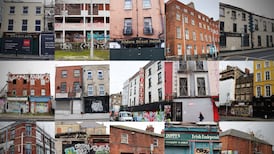The supply of new homes appears to be taking the heat out of the property market with annual inflation falling to just 2 per cent in June, its lowest level in six years. This compares with 12 per cent a year ago.
In Dublin, prices flatlined, rising just 0.1 per cent in the 12 months to June, with house prices unchanged and apartment prices up by 0.1 per cent.
The highest house price growth in the capital was in south Dublin at 3.6 per cent, while prices in Dún Laoghaire-Rathdown, traditionally a bellwether for the market, fell 4 per cent.
The rapid slowdown in property price inflation has been linked to the pick-up in the supply of new homes. New dwelling completions rose by 25 per cent to 18,072 last year and are expected to be up again this year.
The latest figures show residential property prices in the Republic, excluding Dublin, were 3.9 per cent higher in the year to June. The region outside of Dublin that saw the largest rise in property prices was the Border at 14.7 per cent, while the smallest rise was recorded in the mid-east at 0.1 per cent.
Property prices nationally have increased by 83 per cent from their trough in early 2013. Dublin residential property prices have risen 92.7 per cent from their February 2012 low, while residential property prices in the rest of the State are 81.1 per cent higher than in May 2013.
The Eircode with the highest median or middle price for a house purchase was Blackrock and Dublin 6 at €610,000 and €595,000. The 10 most expensive Eircode areas by median price were in Dublin. The least expensive Eircode area within Dublin was Dublin 10 with a median price of €234,500.
Outside Dublin the most expensive Eircode area over the past 12 months was Greystones, Co Wicklow with a median price of €423,722 while the least most expensive was Clones, Co Monaghan with a median price of €66,000.
Affordability and uncertainty
KBC bank economist Austin Hughes said affordability and uncertainty were pushing property price inflation lower.
“A steady and sustained increase in supply has undoubtedly contributed to slower Irish property price inflation of late, both by increasing accessibility directly and lessening panic buying,” he said.
“However, if supply factors were the dominant factor behind the current slowdown in property price inflation, it might be expected that there would also be a marked increase in property transactions,” Mr Hughes said.
However, he noted that the easing in property price inflation had not been accompanied by any acceleration in overall house purchases.
David Grin, chairman of Lotus Investment Group, a Dublin-based investment management firm, said the figures reflected a marked slowdown in house price inflation.
“While many might have assumed that the previous strong property price inflation was good for developers, in reality, stability is good for both the consumer and the developer, as it enables both to plan better over a longer term,” he said.
“Home ownership shouldn’t be speculative from a consumer’s perspective, it should simply be about having your own home,” he said. “Hopefully, the slowdown in house price inflation will lead to a corresponding slowdown in construction cost inflation,” he added.














